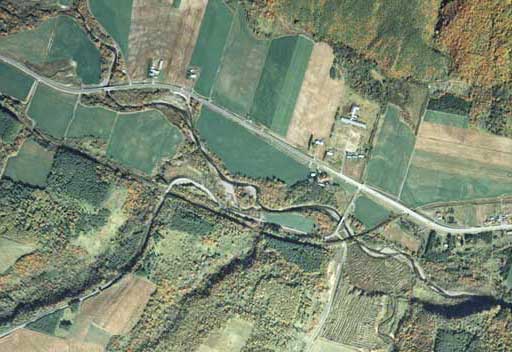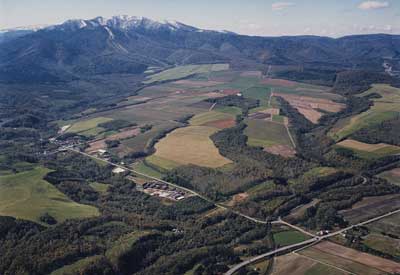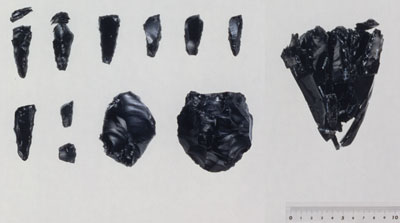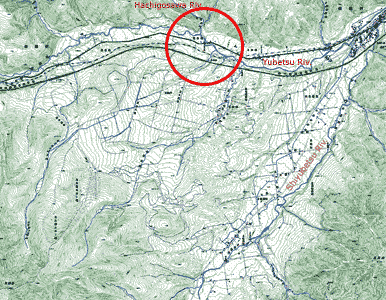Shirataki:
An overwhelming volume of refitted materials revealing the very breath of Paleolithic man

National Land Image(c)Ministry of Land, Infrastructure and Transport, Japan
(Above photo was shot in 1977)
 Concentration of stone tools and flakes (Shirataki Site 1)
Concentration of stone tools and flakes (Shirataki Site 1)
Of 4 million artifacts
less than 1% are well-shaped stone tools, with the preponderance
being large and small flakes produced during stone tool manufacture.
At places where points used for spearheads etc. were made, at times
there are more flakes than soil.
 Distant view of Kami Shirataki district
Distant view of Kami Shirataki district
Sites are frequent atop the river
terrace on the right bank of the Yubetsu river, and large-scale sites
in particular concentrate in the Kami Shirataki district, near the
confluence of the Yubetsu river and the Hachigōsawa river,
linking with the obsidian producing mountain Akaishiyama.
 Refitted materials related to point making (Oku Shirataki Site 1)
Refitted materials related to point making (Oku Shirataki Site 1)
At left is an
item showing reworking after damage, the middle two items and the one
at right are hollow assemblages of refitted flakes that were struck
from the two sides of flat natural stones, from which points were
made as desired and removed from the site. The middle two items show
the inner surfaces of the refitted materials, the one at right is a
separate assemblage with the two halves fitted together.
 Burins, stone cores (above), and refitted materials (right) (Kami Shirataki Site 5)
Burins, stone cores (above), and refitted materials (right) (Kami Shirataki Site 5)
A total of 121 items weighing 509 grams were refitted, including 10
burins, 1 stone core, 13 stone blades and long flakes, 19 flakes
removed from burins (in order to give a new cutting edge), and 78
flakes. Burins aere made by first breaking off the curved end of a
long flake, then retouching both sides. The wider end of the blade is
used for the cutting edge, and the narrower end is the butt hafted
into a handle. When the cutting edge wears with use, force is applied
from the upper right to make a new cutting edge. The small flake thus
removed was refitted in a portion of cases, sometimes showing as many
as 10 instances of reuse. When the body of the blade broke or became
too short, the tool was discarded having outlived its usefulness.
Obsidian was the raw material. The refitted assemblage is 14 cm in
length. The stone core (at the lower right in the photo above) is 7
cm long.
Shirataki Site Group, Shirataki Village, Hokkaido
Naganuma Takashi
"Shirataki Site Group" is a comprehensive label for Paleolithic sites in the village of Shirataki, located in the northeastern foothills of the North Daisetsu range in northeastern Hokkaido. More than 100 sites are distributed atop river terraces of the Yubetsu and Shiyubetsu rivers, flowing through the village toward the Sea of Okhotsk, and over the obsidian producing mountain Akaishiyama.
A total of 4.6 million stone tools and other items, weighing 10 tons, have been recovered from excavations extending to 100,000 m² that have been conducted from 1995 in conjunction with the construction of an expressway. The stone tools include large and small points, large bifacially flaked tools, boat-shaped keeled scrapers, various types of blade and microblade cores, plus large amounts of refitted materials indicating the conditions of manufacture of these items.
Skillful flaking of stone blades and microblades
Standardization is needed in flaking a succession of blades to be used for stone tools, or microblades to be embedded in bone projectile points or knives, requiring careful preparation of the stone core. Refitted materials reveal these conditions in concrete fashion.
Success and failure in projectile point manufacture
Points used as spearheads or knives are made into leaf-like shapes by chipping away bi-directionally both surfaces of a plank-shaped stone or large flake. If failure results in breakage, the item may be reworked if it is in good condition, but discarded if unsalvageable. On the other hand, points produced as intended without failure are taken away from the site, and refitted materials consist of solely of flaked off chips, with a hollow core.
Burins, from manufacture to utilization
Burins, tools for cutting into bone and wood, are made from blades flaked from stone cores. When the cutting edge dulls, a new edge is made, and the item reused. A refitted assemblage of 121 stone pieces, including 1 core and 10 burins, gives eloquent evidence of this process.
The refitted materials obtained from the Shirataki Site Group are truly a boon of information for research on stone tools, a record reproducing stone tool manufacture. In addition, these materials enable us to feel the skill, thinking, and sighs of their makers, to engage in discourse with Paleolithic man.

